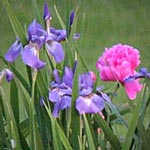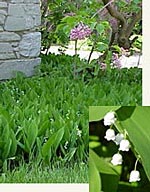|
What is the difference between annual flowers and perennial flowers?
Plants can be classified
as either annual, biennial, or perennial. Annual plants live for
only one growing season, during which they produce seeds, then die. Familiar
annual plants include impatiens, zinnias, and sunflowers. Biennial
plants, such as some types of foxglove, live for two growing seasons before
setting seed and dying. The term perennial is reserved for plants
that live for more than two years.
Trees
and shrubs live for more than two years. Are they perennials?
Technically speaking,
trees and shrubs are perennial plants -- they grow for more than two years.
But horticulturists usually categorize perennial plants into two types:
woody plants and herbaceous perennials. Woody plants are trees, shrubs,
and vines whose above-ground parts persist over the winter, and resume
growth in the spring. In this course we will be focusing on herbaceous
perennials. These are non-woody plants that die back to the ground
each fall. The roots, however, survive the winter and the plants re-sprout
in the spring.
Why
grow perennials instead of, say, a bed of annual petunias, marigolds,
or impatiens?
If you grow lots of
annual flowers, you are familiar with the annual chores necessary to maintain
such beds: you purchase flower seedlings (or start your own), and
plant them. You nurture them throughout the growing season, fertilize
and water them; then, when the season's over and the plants die, you pull
them out. Next year, the cycle begins anew.
Perennial plants remain
in the ground year after year. Once established, many perennials need
minimal upkeep in the form of watering and fertilizing, since their roots
are more far-ranging than annual plants’ roots. Many perennials spread
readily, filling out garden spaces and providing more and more color each
year.
Now that you're sold
on adding perennials to your flower beds, let's look at some common myths,
and discuss why you still might want to include some colorful annuals
in your new perennials gardens.


Class
1, Page 1
2 3
4 5
6
Copyright 2002,
National Gardening Association. All Rights Reserved.
For questions regarding this web site, contact Webmaster
|
|

Perennial
peonies
and
Siberian iris are beautiful
and easy to maintain.
|

Some
plants behave differently in different regions. For example,
lavender and clematis will become woody in regions with mild
winters, but will die back to the ground each winter in colder
regions.
Also,
some plants commonly referred to as perennials, such as rosemary
and iberis, can grow to be small, woody shrubs.
|

Perennials
include groundcovers like lily-of-the-valley, with its clusters
of fragrant, dainty white bells.
|
|